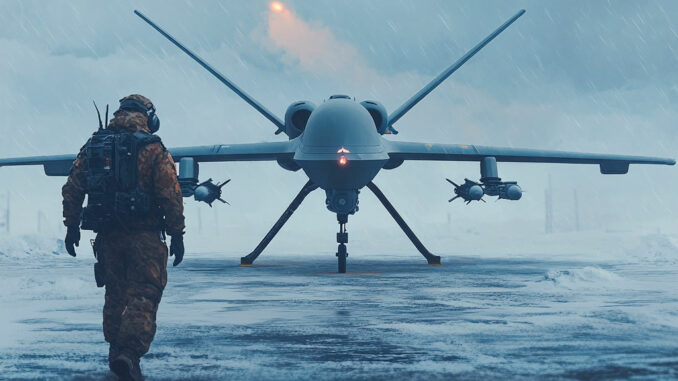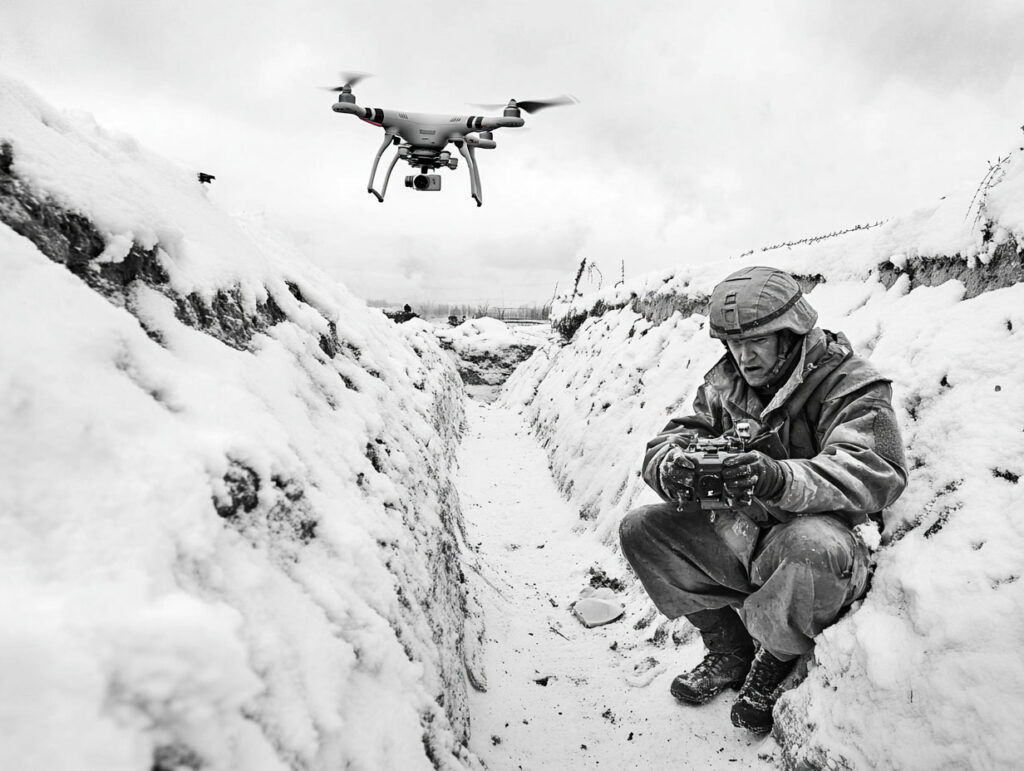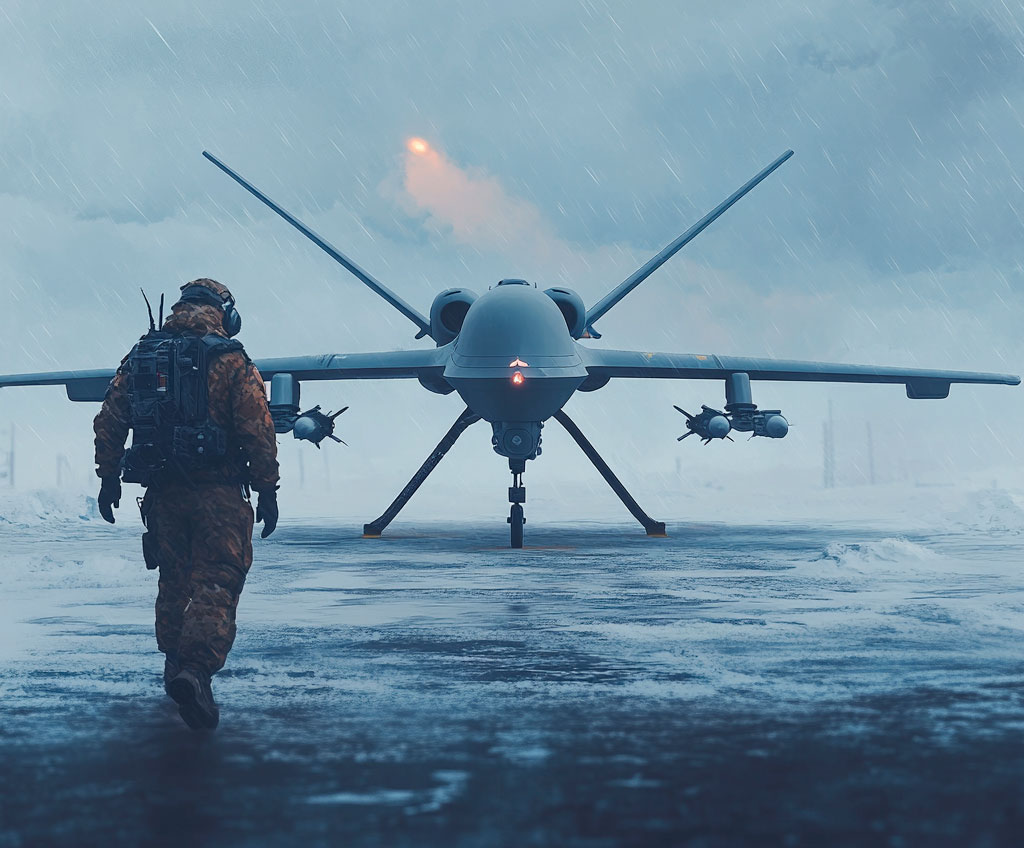
The war in Ukraine has revealed the decisive impact of low-cost armed drones, redefining modern military strategies.
Since the beginning of the conflict in Ukraine, the massive use of armed drones has transformed the battlefield. These low-cost, adaptable devices have replaced much of the traditional air and artillery support, accounting for over 90% of casualties. Ukraine produced 1.5 million drones in 2024, and in 2025, production of long-range drones increased, enabling deep strikes on Russian territory. This led to the creation of the Unmanned Systems Force (USF) to develop and produce new drone models. Drones, especially quadcopters equipped with FPV cameras, have become formidable weapons, capable of carrying out reconnaissance missions and precise attacks. However, the expansion of these operations is limited by the need to train qualified operators, a time- and resource-intensive process. Both sides also use electronic countermeasures to disrupt opposing drones, making electronic warfare essential in this new type of conflict.
The rise of armed drones in Ukraine
The war in Ukraine marked a turning point in the use of armed drones, which rapidly supplanted traditional air support and artillery. In 2024, Ukraine produced around 1.5 million drones, a significant increase on previous years. This massive production has provided Ukrainian forces with a diversified arsenal, adapted to the needs of the modern battlefield. Drones, particularly quadricopters equipped with FPV (First Person View) cameras, have proved to be formidable weapons. These devices, often equipped with an explosive charge of around 500 grams, can be used for reconnaissance missions or for precise attacks on enemy targets. Their relatively low cost and ease of production have enabled rapid adoption and effective integration within military units. This has led to a redefinition of military strategies, with drones now playing a central role in both offensive and defensive operations.

Training drone operators: a strategic challenge
One of the main challenges associated with the massive integration of drones on the battlefield is operator training. Unlike traditional weapons systems, drones require specific technical expertise and a thorough understanding of remote control systems. Initial operator training usually includes a period of apprenticeship as an assistant, where the trainee becomes familiar with navigation systems, communication protocols and piloting techniques. This phase is followed by intensive practical training, including mission simulations and real-life exercises. According to military standards, the complete training of a drone operator can extend over several months, or even years, depending on the complexity of the systems used. For example, to pilot tactical UAVs like the Patroller, two years’ training is required. This demand on time and human resources represents a logistical challenge for armed forces, who have to balance the need to rapidly deploy drones in the field with the need to train competent operators.
Long-range drones: a new strategic dimension
The evolution of UAVs is not limited to small-scale devices used for reconnaissance or close-range attacks. Ukraine has also invested in the development of long-range drones, capable of striking targets several hundred kilometers away. These drones, often of fixed design, can carry larger payloads and are equipped with advanced navigation systems, enabling them to penetrate deep into enemy territory. For example, Ukrainian drones have been used for strikes on critical infrastructure in Russia, demonstrating their ability to reach strategic targets. This ability to project power over long distances offers a significant advantage, making it possible to disrupt enemy supply lines, target key military installations and create a deterrent effect. However, such operations also entail risks, including the possibility of retaliation and the challenges of navigating contested airspace.
Electronic countermeasures: an invisible war
With the proliferation of drones on the battlefield, electronic countermeasures have become an essential element of modern warfare. Both sides have developed techniques to disrupt or neutralize opposing drones, notably by jamming control signals or suppressing GPS communications. These measures can render a drone inoperable, forcing it to land or return to its point of departure. For example, jamming systems have been used to interfere with drone communications, rendering them unable to transmit data or receive commands. In response, anti-jamming technologies were developed, including redundant communication systems, frequency hopping algorithms and the use of secure data links. This electronic arms race has added a new dimension to warfare, where technological superiority and the ability to adapt rapidly to emerging threats are crucial.

Strategic and military consequences of drone use
The integration of drones into military operations has profound implications for strategy and tactics. On the one hand, drones offer a continuous surveillance capability, providing commanders with a real-time picture of the battlefield. This enhanced situational awareness facilitates decision-making and rapid adaptation to changing terrain conditions.
On the other hand, the massive use of armed drones has changed the way land forces operate. In a context where drones can neutralize armored vehicles and fortified positions with increased precision, attack and defense strategies need to be adjusted. For example, armored formations need to incorporate anti-drone systems to minimize their vulnerability.
The strategic implications also extend to the geopolitical level. Ukraine has developed a local drone industry capable of competing with more expensive systems, such as Iran’s Shahed-136s, which sell for around €200,000 each. In comparison, Ukrainian drones, sometimes assembled in domestic workshops, cost less than 20,000 euros, offering unrivalled cost-effectiveness. This competitiveness is prompting other nations to rethink their own combat doctrine and accelerate the adoption of low-cost, adaptable drones.
The future of air and ground combat dominated by drones
The success of drones in Ukraine has sparked growing interest from the major military powers. The USA, China and Israel are investing heavily in similar developments, with a particular focus on autonomous drones and swarm combat systems. These systems enable dozens or even hundreds of drones to coordinate their actions to saturate enemy defenses and optimize precise strikes.
Furthermore, the evolution of countermeasures will continue to shape the development of military UAVs. While electronic jammers remain effective, the emergence of artificial intelligence applied to autonomous drones could reduce their dependence on radio-frequency communications, making them more resistant to electronic attack.
Finally, the proliferation of drones raises questions about the regulation of their use in armed conflict. The use of kamikaze drones and semi-autonomous systems raises ethical and legal debates about responsibility for acts committed by these machines.
War Wings Daily is an independant magazine.